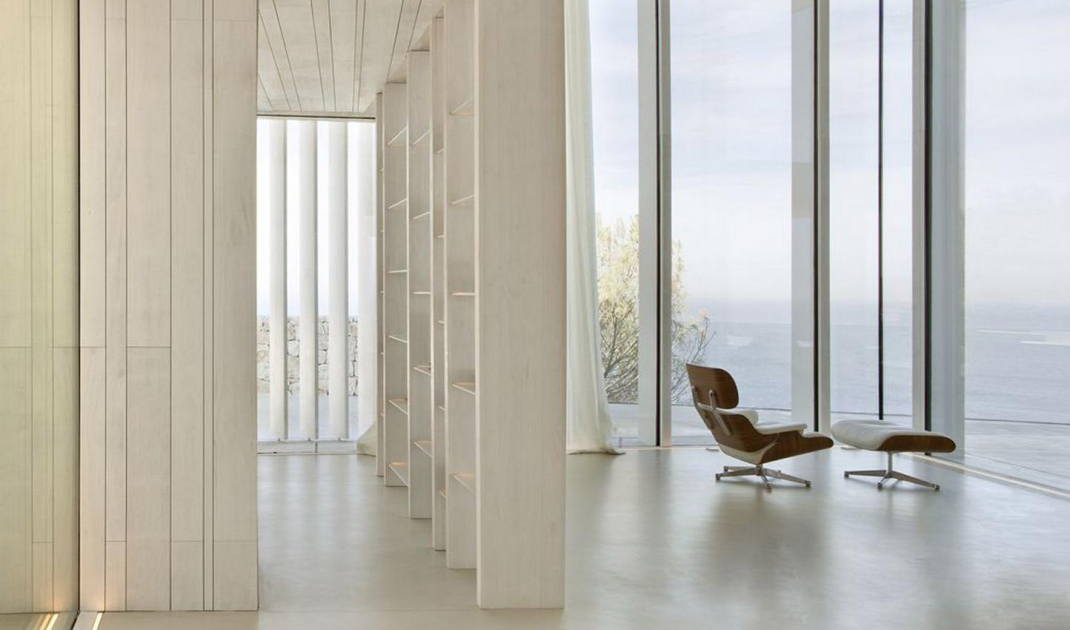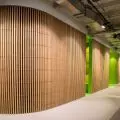In rooms exposed to moisture and frequent dirt, surfaces are traditionally lined with ceramic, glazed or porcelain tiles. They allow to create interesting, modern composed surfaces. Maintenance of the tiles themselves is not particularly demanding, but their weak point is the need to leave gaps between the modules. Filling them with cement gro ut causes problems with keeping it impeccably clean. An excellent alternative may be to finish the surface seamlessly with micro-cement.
Aesthetically pleasing seamless floor surface in living room and walls in minimalist bathroom
Seamless surface using microcement
Microcement is a mortar, consisting of polymer resins, high-performance cement, hard aggregates, pigments and modifying admixtures. It looks like raw concrete, but will not crumble or dust. Nanocement is just a 2- to 3-millimeter layer, which is usually applied over a precisely leveled and primed cement substrate beforehand. However, thanks to its excellent adhesion, it can also be used on many other structures, such as wood, wood-like materials, ceramic tiles and even glass or plastic.
Surfaces can be made with a complete omission of expansion joints, creating a smooth and even finish. They are uniform, which greatly improves aesthetics and the convenience of cleaning them. They work well on large slopes, in places such as halls, spacious living rooms or offices, but are also used in the rooms of private homes.
Pink microcement applied to surfaces in the bathroom
Properties of microcement
Microcement surfaces are hard and resistant to mechanical damage, scratches and abrasion, so they will work well as floors. Since it has high elasticity, so it does not crack at higher temperatures, we can even cover the fireplace surround with it, or use it in a sauna.
Some versions of microcement, those with added resins, will resist permanent moisture, allowing it to be used for floors and walls (for example, in the bathroom, in thekitchen over the countertop or in the living room), but also for sinks, bathtubs or shower trays, which will fit perfectly into a bathroom in a raw, ascetic style. Microcrete flooring is non-slip, that is, fully safe in spaces exposed to frequent contact with water.
Such a surface will also not be intimidated by household chemicals and grease. It can only be weakened or discolored by strong acidic agents.
Unlike many resins, microcement does not contain bromine, which is a strong allergen, so it is not allergenic.
Sanded and cleaned layer of microcement
Workmanship conditions
Microcement surfaces are most often made to order. For a smaller area, you can also use kits to finish the surface yourself.
The suitable temperature for making such a floor is about 10-25 oC. A dry substrate is necessary , with a maximum of 4% moisture content. When covering traditional cement screed or cement-lime plaster, you should wait a minimum of 4 weeks.
Before laying the microcement, you need to remove any dirt that can weaken the adhesion of the coating. If the substrate is dusty, it should be reinforced with a deep penetrating primer.
Thefirst layer of microcement - structural, is made of a thick coarse-grained compound. The second, fine-grained, is thinner. The short setting time of the mass can make it difficult to apply. When laying it, do not take breaks, because, it will be visible in the final result.
The final steps are sanding the layer and cleaning it, and an optional topcoat.
Microcement surfaces in minimalist interiors
Minimalist character of microcement
Microcement works well in both interiors and exteriors. The material can be used on walls, floors and to create monolithic stairs. Microcement fits perfectly into minimalist or industrial interiors. To break the impression of coolness and austerity that it brings with it, we can combine it with accessories made of wood, or warm it up by choosing an appropriate color version. The finish of the coating can be matte, satin or shiny.
The surface can be smoothly sanded or textured with a suitable tool. It is also possible to achieve the effect of varying shades, without structural pitting, as in the case of architectural concrete. Also, it will blend perfectly with glass, ceramics and will be an excellent background for natural greenery.




































